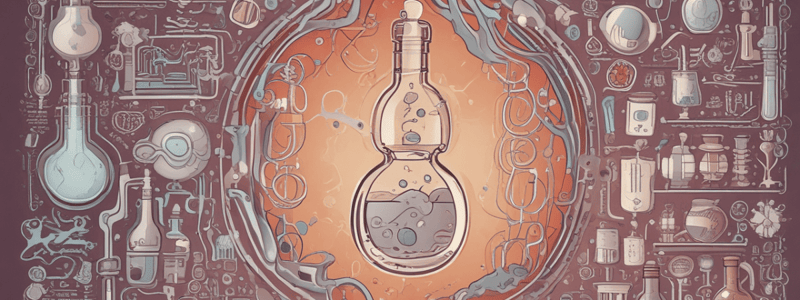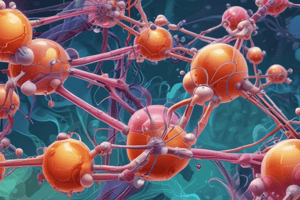Podcast
Questions and Answers
What is the force that attracts electrons to protons in an atom?
What is the force that attracts electrons to protons in an atom?
- Electrostatic force
- Nuclear force
- Gravitational force
- Electromagnetic force (correct)
What does an atom's atomic number indicate?
What does an atom's atomic number indicate?
- The number of electrons
- The number of neutrons
- The number of protons and neutrons
- The number of protons (correct)
In which state of matter are the attraction forces between molecules negligible?
In which state of matter are the attraction forces between molecules negligible?
- Liquid
- Solid
- Gas (correct)
- Plasma
What is reactivity a measure of?
What is reactivity a measure of?
What is the nuclear force responsible for?
What is the nuclear force responsible for?
What is the mass number of an atom a measure of?
What is the mass number of an atom a measure of?
What is the primary focus of chemistry as a field of study?
What is the primary focus of chemistry as a field of study?
Which branch of chemistry deals with the study of chemicals containing carbon?
Which branch of chemistry deals with the study of chemicals containing carbon?
What is the smallest particle of an element that cannot be divided into smaller parts by ordinary chemical processes?
What is the smallest particle of an element that cannot be divided into smaller parts by ordinary chemical processes?
What is the role of electrons in an atom?
What is the role of electrons in an atom?
What is the location of the nucleus in an atom?
What is the location of the nucleus in an atom?
What carries a positive charge in an atom?
What carries a positive charge in an atom?
What is the relationship between chemistry and other branches of science?
What is the relationship between chemistry and other branches of science?
Which of the following statements about matter is true?
Which of the following statements about matter is true?
Study Notes
Introduction to Chemistry
- Chemistry is the study of matter, its structure, composition, and changes that occur when it is exposed to various situations.
- Chemistry investigates the qualities of matter and how and why it changes.
Branches of Chemistry
- There are five main disciplines of chemistry:
- Organic chemistry: deals with the study of chemicals containing carbon.
- Inorganic chemistry: deals with the study of chemicals that do not, in general, contain carbon.
- Physical chemistry: deals with the study of the rates of chemical reactions, or the physical structure of materials at the molecular level.
- Analytical chemistry: is the study of the composition of substances.
- Biochemistry: is the study of chemical processes that occur in living things.
Structure of an Atom
- All matter is made up of atoms.
- An atom is the smallest particle of an element and cannot be divided into smaller parts by ordinary chemical processes.
- An atom consists of three subatomic components:
- Protons: have a positive charge.
- Electrons: have a negative charge.
- Neutrons: have no charge.
- Virtually all of an atom's mass is in the protons and neutrons in the nucleus.
- Electrons surrounding the nucleus have almost no mass.
- Electrons are attracted to the protons in the nucleus by electromagnetic force.
- Protons and neutrons in the nucleus are attracted to each other by nuclear force.
Atomic Number and Mass Number
- Atomic number: indicates the number of protons in an atom.
- Mass number: is the number of protons and neutrons in the nucleus.
States of Matter
- There are three states of matter:
- Solid state: attraction forces between solid molecules are very strong.
- Liquid state: attraction forces between liquid molecules are average.
- Gas state: attraction forces between gas molecules are negligible.
Chemical Properties of Matter
- Chemical properties of matter include:
- Reactivity: the tendency of matter to combine chemically with other substances.
- Flammability: the tendency of matter to burn.
- Toxicity: the extent to which a chemical element or a combination of chemicals may harm an organism.
- Acidity: a substance's ability to react with an acid.
Studying That Suits You
Use AI to generate personalized quizzes and flashcards to suit your learning preferences.
Description
Introduction to medical chemistry, covering the study of matter, its structure, composition, and changes. This lecture is taught by Dr. Wael Sobhy Darwish, a Biochemistry PhD.




